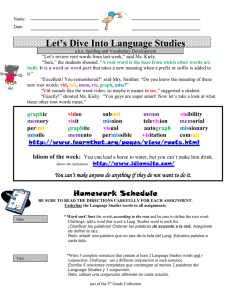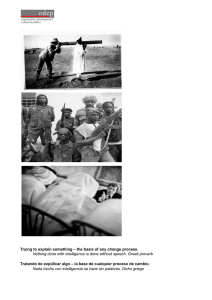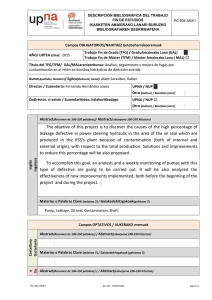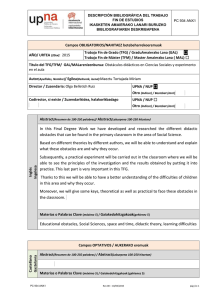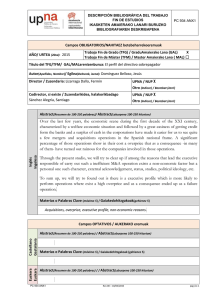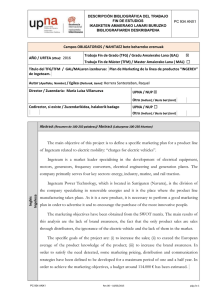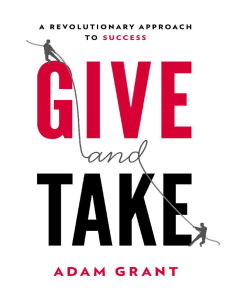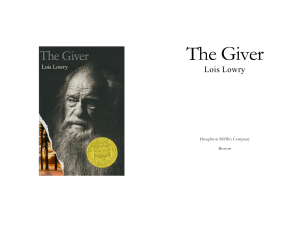Tópicos 7mo 2do Semestre 2016
Anuncio
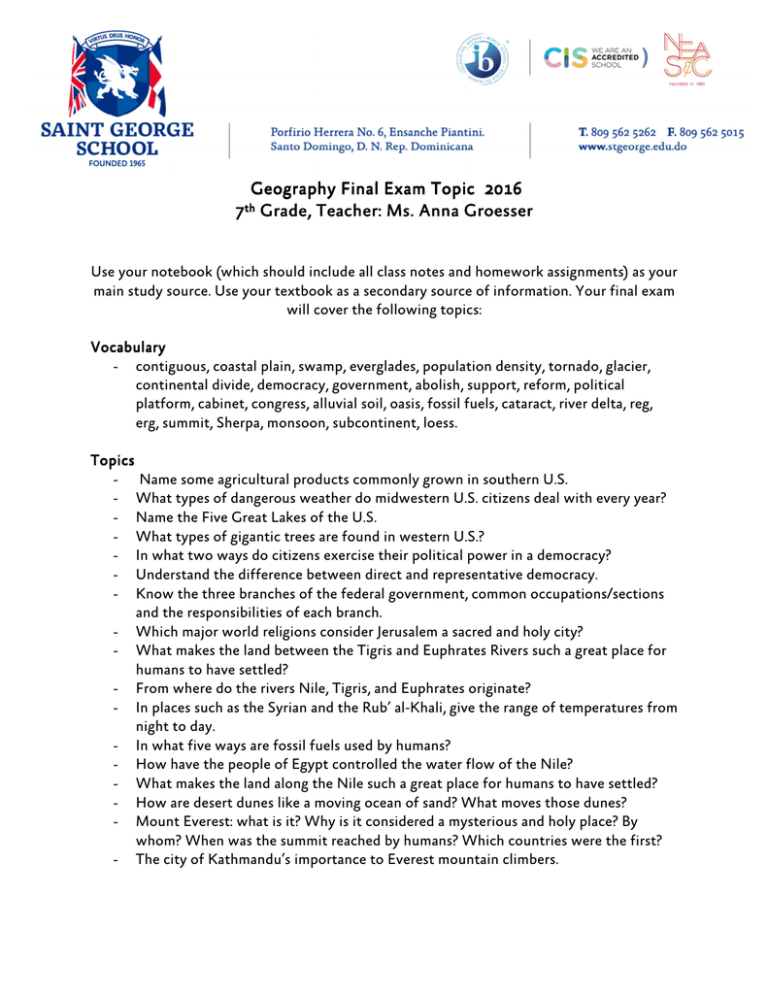
Geography Final Exam Topic 2016 7 th Grade, Teacher: Ms. Anna Groesser Use your notebook (which should include all class notes and homework assignments) as your main study source. Use your textbook as a secondary source of information. Your final exam will cover the following topics: Vocabulary - contiguous, coastal plain, swamp, everglades, population density, tornado, glacier, continental divide, democracy, government, abolish, support, reform, political platform, cabinet, congress, alluvial soil, oasis, fossil fuels, cataract, river delta, reg, erg, summit, Sherpa, monsoon, subcontinent, loess. Topics - Name some agricultural products commonly grown in southern U.S. - What types of dangerous weather do midwestern U.S. citizens deal with every year? - Name the Five Great Lakes of the U.S. - What types of gigantic trees are found in western U.S.? - In what two ways do citizens exercise their political power in a democracy? - Understand the difference between direct and representative democracy. - Know the three branches of the federal government, common occupations/sections and the responsibilities of each branch. - Which major world religions consider Jerusalem a sacred and holy city? - What makes the land between the Tigris and Euphrates Rivers such a great place for humans to have settled? - From where do the rivers Nile, Tigris, and Euphrates originate? - In places such as the Syrian and the Rub’ al-Khali, give the range of temperatures from night to day. - In what five ways are fossil fuels used by humans? - How have the people of Egypt controlled the water flow of the Nile? - What makes the land along the Nile such a great place for humans to have settled? - How are desert dunes like a moving ocean of sand? What moves those dunes? - Mount Everest: what is it? Why is it considered a mysterious and holy place? By whom? When was the summit reached by humans? Which countries were the first? - The city of Kathmandu’s importance to Everest mountain climbers. - Understand monsoon winds of India; difference between winter and summer and why. Explain why China’s Yellow River is colored a brownish-yellow, and why this river is nicknamed the Mother of China. Map Knowledge - Know the location of the: seven continents, five oceans, Prime Meridian, Equator, the mountain ranges (Himalayas, Rockies, Appalachians), desert (Sahara), rivers (Mississippi, Nile, Tigris, Euphrates, Yellow), seas (Caribbean, Mediterranean). Mathematics Final Exams Topics 2016 1 st Form, Teacher Sarah Gómez Chapter 3 - Real Numbers and the Coordinate Plane 3-1 Exploring Square Roots and Irrational Numbers, p.106 3-2 Pythagorean Theorem, p.112 3-3 Using the Pythagorean Theorem, p.118 3-4 Graphing In the Coordinate Plane, p.124 3-5 Equations, Tables and Graphs, p.130 3-6 Translations, p.136 3-7 Reflections and Symmetry, p.141 Chapter 4 - Applications of Proportions 4-1 Ratios and Rates, p.160 4-2 Converting Units, p.166 4-3 Solving Proportions, p.172 4-4 Similar Figures and Proportions, p.181 Chapter 55- Applications of Percent 5-1 Factions, Decimals and Percents, p. 210 5-3 Percents and Proportions, p.218 5-5 Percents of Change, p.230 5-6 Markup and Discount, p.234 Chapter 6 – Equations and Inequalities Inequalities 6-1 Solving Two-Step Equations, p.261 6-2 Simplifying Algebraic Expressions, p.266 6-3 Multi-Step Equations, p.271 6-4 Solving Equations with Variables on Both Sides, p.276 6-5 Solving Inequalities by Adding or Subtracting, p.282 6-6 Solving Inequalities by Multiplication or Division, p.288 Chapter 8 -Measurement 8-1 Solids, p.352 8-2 Drawing views of three-dimensional figures, p.358 8-3 Nets and three-dimensional figures, p.364 8-4 Surface areas of prisms and Cylinders, p.368 8-5 Surface areas of pyramids and cones, p.374 8-6 Volumes of prisms and cylinders, p.380 Chapter 9 – Using Graphs to Analyze Data 9-1 Finding Mean, Median and Mode, p.412 9-2 Displaying Frequency, p.418 9-3 Venn Diagrams, p.424 9-4 Reading Graphs critically, p.428 9-8 Circle Graphs, p.450 Remember to study from your notebook, book, quizzes we have done. Tópicos Lengua y Literatura 7th 2do Semestre 2016 Profesoras Rita de Pérez y María Cruz Gramática. 1. El adjetivo calificativo. Funciones y grados, positivo, comparativo, superlativo. 2. Adjetivación comparación. símil y metáfora. 3. Tipos de descripción. Retrato Etopeya, prosopografía, cronografía, zoografía, autorretrato, topografía, caricatura. 4. Palabras antónimas y sinónimas., homónimos homófonos 5. Pronombres. Funciones y clases 6. Personales y nominales. Átonos y tónicos. 7. Palabras con plurales dudosos. Terminados en S en Z, palabras compuestas, palabras terminadas en vocal acentuada o con tilde. 8. Nexos oracionales. Palabras de enlaces. 9. Preposiciones y sus funciones 10. Conjunciones: Copulativas adversativas, disyuntivas, distributivas, explicativas. Coordinadas y subordinadas y su clasificación. 11. Palabras que se pueden escribir juntas y separadas y su función. 12. Textos escritos en versos, en prosa. Establecer diferencias entre géneros. 13. Palabras polisémicas. Definición, y características. 14. El adverbio. Concepto. Funciones. Clasificación semántica., relación del adverbio con el verbo y el adjetivo. Convertir adjetivos en adverbios con el sufijo mente. 15. El sintagma nominal y predicativo. Complemento directo, oposición, atributo. 16. Oraciones copulativas, transitivas e intransitivas Elementos de la comunicación. comunicación. 17. Niveles de la lengua. Definición y clasificación. Coloquial, estándar, formal, literaria, no literaria, regional. 18. La Novela, los géneros literarios. Características principales. Análisis. Textos en prosa. Ortografía. 19. Ortografía. Reglas para el uso de las letras b, v, ll, y, s, c, x, z. Redacción 20. La raya y el paréntesis y sus funciones como signos ortográficos. 21. El Ensayo, género literario. . Características. Estructura. Pedro Henríquez Ureña como ensayista. Importancia. Origen. Literatura 22. El teatro, género dramático y sus principales elementos dramáticos. 23. Géneros Literarios. El Modernismo. 24. Viaje al centro de la Tierra, autor, trama de obra personajes principales. RdeP y MC Tópicos Ciencias Sociales 7mo Grado 2do Semestre 2016 Prof. Xiomara Espinosa Fundación de la Republica • Dominación Haitiana • Crisis de la dominación haitiana. • Proclamación de la Independencia • Primer gobierno dominicano • Gobierno de Santana • Gobiernos de Santana y Báez. Anexión y Segunda República. • Proyecto anexionista • Guerra Restauradora • Fin de la Restauración • Segunda República • Gobiernos de Báez y Cabral, Independentismo y antillanismo • Primera guerra de independencia cubana • Independentismo puertorriqueño • El antillanismo • Próceres antillanos • Independencia de cuba. Liberalismo y dictadura • Gobiernos de González y Espaillat • Gobiernos azules • Fin de los gobiernos azules • Dictadura de Ulises Heureaux Language Arts Final Exam Topics 2016 7 th Grade, Teacher: Elizabeth Magee and Rose de Dominguez I – Literary Elements: Students must be able to define and identify examples of the following literary elements from The Outsiders and The Giver. • Characters • Setting • Plot Elements • Themes (see below) II –Themes: Students must be able to identify and describe the following themes from The Outsiders and The Giver. The Outsiders The Giver • Loyalty to Self/Loyalty to Others • Freedom vs. Security • Loss of Innocence • Logic vs. Emotion • Othering • Conformity vs. Diversity • Violence vs. Peaceful Problem-Solving • Role of Family, Language and/or Knowledge in Society III – Study the following selections and books read and discussed in class: • The Outsiders • The Giver IV – Grammar: Students must be able to identify and use these grammar rules correctly. • Identifying coordinating conjunctions • FANBOYS • SWABIs • THAMOs • Verb Tenses • Commonly Confused Words V – Writing: Students must be able to write/edit a paragraph or essay using the IPEEL format. • Introduction o Explanation • Point o Link • Example Use NoRedInk, The Outsiders, The Giver and your notebook to prepare. Topics Science Final Exam, Exam , 7th Grade, Teacher : Mr. Luis González Cellular Energy ● Photosynthesis ● Cellular respiration and ATP ● The Chloroplasts ● The Mitochondria Plants ● ● ● ● ● Characteristics of plants Main groups of plants Characteristics of vascular plants Characteristics of nonvascular plants How are flowers pollinated ● ● ● ● Characteristics animals share Characteristics of vertebrates Characteristics of invertebrates The phyla of the animal kingdom Animals Body systems ● Main function of body systems ● What is homeostasis ● Diseases caused by a disruption in homeostasis The skeletal and muscular systems ● Main functions of the skeletal system and Muscular system ● Parts of the skeletal system ● Composition of the bone ● What are joints ● Injuries and disorders of the skeletal system ● ● ● And muscular system ● Types of muscles The circulatory and respiratory system ● Cardiovascular and lymphatic systems ● Parts of the cardiovascular system ● What is blood made of ● Parts of the respiratory system ● Flow of air through the respiratory system The digestive system ● Function of the digestive system ● Parts of the digestive system ● Mechanical digestion ● Chemical digestion The nervous system ● Function of the nervous system ● The CNS and PNS ● Parts of the CNS and PNS ● The main senses
